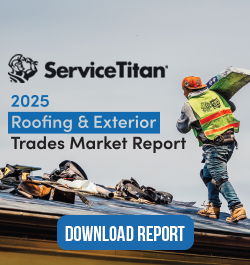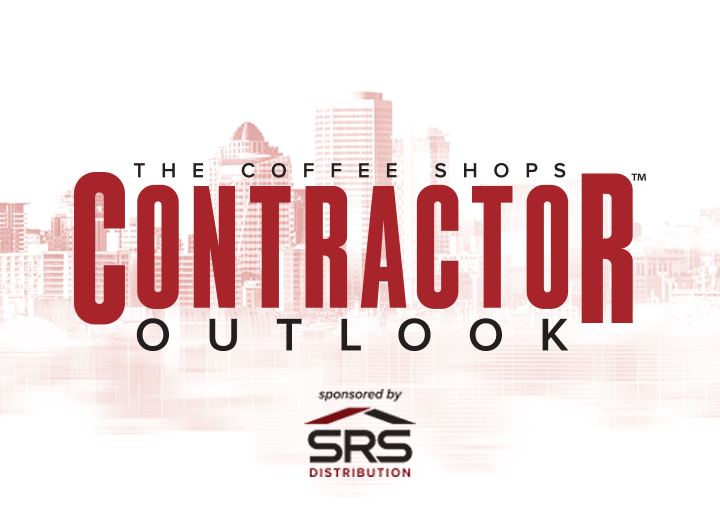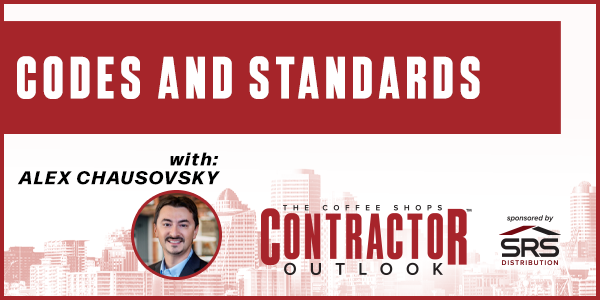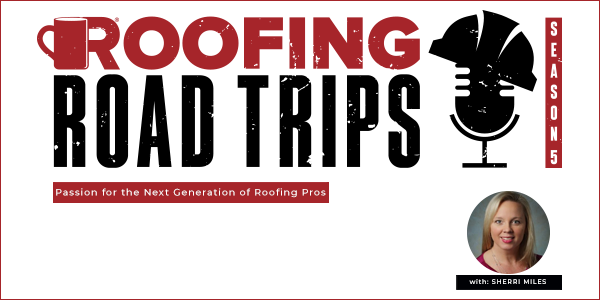Codes and Standards - PODCAST TRANSCRIPT
July 10, 2025 at 2:00 p.m.Editor's note: The following is the transcript of a live interview with Alex Chausovsky, director of analytics and consulting at the Bundy Group. You can read the interview below, listen to the podcast or watch the recording.
Intro: Hello and welcome to Contractor Outlook newscast from The Coffee Shops. My name is Heidi Ellsworth and this newscast is really talking about the big picture. What is happening out there in our economy globally and specifically in construction. We bring leading speakers, presenters, experts, within many different disciplines to the show. And today I am very excited to welcome the director of analytics and consultants from The Bundy Group, Alex Chausovsky, to the Contractor Outlook today. Alex, welcome.
Alex Chausovsky: Thanks so much for having me, Heidi. It's a pleasure to be here.
Heidi Ellsworth: Oh my gosh. Karen Edwards, who works here at the Coffee Shops as our COO, saw you speak at a recent convention and was blown away. She came back and she said, "Alex explained things in a way that I could totally understand and really made sense." So you have high referrals and recommendations there.
Alex Chausovsky: Well, I'm glad to hear that my presentation was of value to her and to the group overall. I've worked with many of the companies in the middle construction industry historically and so I try to connect the dots between what's going on in the economy and what they should be doing about it and always good to have such positive feedback.
Heidi Ellsworth: I love the action plan. That always makes a difference. You hear everything, but sometimes you're like, "I don't know what to do." So let's start this Contractor Outlook newscast out with introduction. So if you could introduce yourself, tell us a little bit of your history and also what you do as director of analytics and consulting at The Bundy group.
Alex Chausovsky: Yeah. Absolutely. So Alex Chausovsky, as you mentioned, I work leading the analytics and consulting practice at a small boutique investment bank, which is what The Bundy group is. So I help with everything from providing some clarity in terms of the direction of the economy to all the way assisting business leaders and owners in a sale, an acquisition or some capital financing. Raising money to invest in future growth. And my career has really been focused around one simple concept, which is how can I help people that are responsible for making business decisions leverage data in an objective analysis in order to make the best quality decisions? And that stems everything from the macroeconomic environment, to technological trends, to labor market conditions and now with what's been going on lately in the world geopolitical developments too. So all of these things have an impact and my job as I see it, is to break it down for folks, help them understand what's happening and as I mentioned earlier, what they should be doing in response to the landscape.
Heidi Ellsworth: I love it. I love it. Okay. Well let's start with that big picture.
Alex Chausovsky: Okay.
Heidi Ellsworth: We're at the end of Q1. What are we looking at with the economy right now?
Alex Chausovsky: Yeah. So there's a few ways to look at macroeconomic performance. Globally I think if we look at the totality of 2024, I would say it was a very strong year, some good momentum. Certainly within the US that is very true. We grew the economy as measured by GDP or the gross domestic product, which is the catchall of economic activity in the United States by about two and a half percent last year, which is above the historic pace of 2%. That's good news. We also had some really nice momentum coming into 2025. There are basically three components to GDP. There's government spending, there's business investment and then there's the personal consumption element with that personal consumption being by far the largest driver. That means that you and I as individual consumers and everybody listening to this podcast, we are the main growth engine for the US. We account for about two thirds of overall GDP and then there are other elements both business investment and government spending, roughly speaking about 17% each. So they're also important but not as critical from a health of the overall economy perspective as how people are acting and feeling about the outlook.
So the good news is that the data all the way through February ... I don't quite have March's figures yet because we're here in the last day of March recording this podcast. But the data for both business investment and personal consumption showed not only resilience through February, but we actually had the semblance of acceleration happening both in industrial production, which is the benchmark for that B2B world, the industrial economy, the manufacturing economy if you will and in the retail environment, which is the best way for us to measure personal consumption. So both data series that I follow that are benchmarks for those parts of the economy showed that short-term growth rates were actually accelerating, meaning that down the road about two to three quarters down the road, we should see the annual growth rate also rise in a positive direction.
Now of course, all of that is before the policy agenda has really started to take effect. The biggest I think change in the last four to six weeks has been the executive orders that President Trump has signed on a variety of items predominantly on trade with tariffs now in place on our trading partners to the north and south in Canada and Mexico, on China on specific product categories like steel and aluminum of course, which is critical to the metal construction industry on cars. And more expected imminently by April 2nd, we should get word on things like reciprocal tariffs, other product categories potentially like copper and semiconductors and pharmaceuticals. So this has been the biggest difference maker in terms of not necessarily in the hard data, which is what I was talking about earlier, that measures the dollar flow, but in sentiment. How do people feel about the economy and what do they expect to happen in the near term? And really these developments have been detrimental for a lack of a better word in terms of the sentiment that we have. So consumer sentiment has fallen off a cliff in the last few months. This is measured by the University of Michigan consumer sentiment index. We have business optimism also pulling back substantially compared to the few months after the election where businesses were looking forward to lower taxes, less regulation and had a very optimistic outlook. We've seen that pull back substantially.
So I don't think it's fair to say that our recession is in the cards at this point because the hard data does not support that. But sentiment and the perception of the future does eventually turn into behavior. So my hope here as we sit at the end of Q1 and look out towards Q2 and the second half of the year is that the uncertainty, the ambiguity that has been created by these tariffs and other policy initiatives on immigration and tax cuts and things are able to be contained within a relatively short timeframe. If we can accomplish that, then sentiment should bounce back and we should continue to see growth in the economy. If that is not something that is dealt with in the short term, if we see this uncertainty carry over into the second half of the year, certainly then it's going to be very hard to overcome the headwinds of that because both consumers and businesses will pump the brakes on spending. You combine that with potential cuts from Doge in the government section of the economy and the math is very quickly aligning in a way that is very difficult to see a continuation of the type of momentum that we saw prior to the dissension of chaos, if you will, related to all of these uncertainties. So that's my macro economic perspective as we sit here at the end of March.
Heidi Ellsworth: And just a clarifying question. So I find this absolutely amazing or so intriguing I guess is more the word, is that you saw in January and February an increase in consumer spending and also in industrial spending and it looks very positive. But sentiment continues to go down. So is there a point, is it like when they cross at a certain point that all of a sudden the spending starts pulling back? I just would love a little bit more on that. You said if we can contain it, but how can you contain it? It's interesting where we're at right now.
Alex Chausovsky: Sure. So I think the biggest challenge that needs to be figured out is this not knowing of what's happening. I heard this talked about very recently by one of the voting members of the federal open market committee. This is the part of the fed that decides interest rate policy, which I'm sure we'll talk about some on the recording. And they talked about we are currently in a very thick fog. It's not the fog that you can turn on your high beams and drive through. It's so thick that you have to almost pull over to the side of the road and wait for it to settle or to blow through because you don't know if 50 feet ahead of you is another 90 degree turn. So that's what I'm talking about when I talk about the sentiment translating into behavior down the road. If we are able to say in the next two to three months, at least know what the tariff landscape looks like moving forward. Not have this uncertainty or the ambiguity of what percentage tariffs are going to be in place on what product categories. If we know what it is, then both businesses and consumers can start to adapt to that in the case of businesses by changing pricing, by making sure that they're maintaining profitability at desired levels. But it's the uncertainty that's really causing this inability to do anything. We're almost like deer staring at some headlights.
So I would say there's not a numerical time lag relationship that I can give you specifically between sentiment and then actual activity. Logically speaking, I would think two to three months before you start to see a real pullback in consumers closing their wallets, businesses delaying projects, maybe in some cases even canceling projects. That's why I say if we can keep this contained to the first half of the year, then there's still enough time in the second half for us to rebound. If we can't it goes into Q3, into Q4, then there's not enough time for the recovery to take place.
So my opinion right now is if on April 2nd when President Trump makes the big announcement ... He's calling it liberation day for a lack of a better word. However you feel about that, if we actually do get some clarity about what's going to happen that will allow people to start adapting. Until we have that clarity, it's almost impossible to figure out what direction it's going to go into. And so the result of that is continued drawing out or kicking the can down the road and that is not conducive to economic activity therefore the data I imagine will start heading south by time we get into mid second quarter, late second quarter and then really start to feel that negativity in the second half of the year without the clarity that we're all hoping for.
Heidi Ellsworth: And the stock market has been reacting way in advance. It's already reacting.
Alex Chausovsky: Businesses hate uncertainty, but certainly people who hold and trade stocks hate uncertainty. And so we've seen the result of that. Now, the stock market does not necessarily correlate to the economy. I think it's important to establish that notion. There's only about a 50% correlation between stocks and economic performance. Now stocks certainly do fluctuate because people make bets and we also have to keep in mind that we were coming off a very high elevated earnings to stock prices ratios. So people are locking in some of the profits. That's part of what's going on right now. They're expressing their pessimism about the future by getting out of the market, going more to safe haven assets like gold for example or treasuries, which are risk-free bonds sold by the US government. So some of that is a realization that the high-flying days of late 2024 are probably behind us. Some of it is the pessimism about the future. But I caution people to make the connection between the economy and the stock market directly because there's not a lot of correlation there.
Heidi Ellsworth: That's interesting. That's great advice too. So if we bring this down, everything we've just talked about into the construction zone, metal, roofing, general contractor, big buildings, new commercial, all that, residential and new homes, what are you seeing there right now?
Alex Chausovsky: Yeah. So the construction sector is definitely what I would call on the back side of the business cycle, which means that we're clearly coming off of some peak growth rates that we're experienced in, I would call it around the early to mid-part of 2023, which is when we saw the growth, particularly in the non-residential sector of the market peak. And we've been slowing since then. The residential market has obviously been significantly affected by the interest rate environment more so than the non-residential sector. And so single family housing has been weak. Multifamily housing was more robust as we were building out apartment complex. That's starting to slow pretty dramatically too. And eventually we'll probably see some downside pressure. But I think from the metal building construction perspective, really the focus should be on sectors like office and manufacturing construction. That's where most of the demand side pull comes from. And in those categories, we are very clearly in that back of the cycle slowing pretty dramatically, still in slightly positive territory, year-over-year growth rate. Concerned but the momentum is further pressure to the downside.
Now, I don't want to say that as a blanket statement because there are very much exceptions to that rule. A lot of the exception can be seen in the office and in the manufacturing sector, in office construction, particularly the data center build-out that's driven by AI adoption and the need for compute power. That's been going really, really strongly. In fact, data centers are now accounting for a much larger portion of office construction. And this is both new builds ... I'm talking about massive exascale data centers where they're putting up brand new facilities from greenfield property perspective. And the refit or the remodeling aspect. One of the things that I've seen quite a bit of is existing office space within major cities. The vacancy rates are still pretty high because people have not returned to work full-time and there is a lot more people today working remotely than there were before the pandemic. But I would say that they're taking some of that existing office space and refitting it into data centers on a smaller scale, but still enough because there's already the built-out air conditioning and the cooling and the water that data centers need to operate.
So that opportunity I still think is going to be very advantageous for the metal construction sector as we move throughout 2025 and into '26. This is really regardless of what happens in the macro environment because the need for compute doesn't go away as we adopt AI. Then the second element in the manufacturing space that I think is a a bright spot of opportunity is the semiconductor space within the manufacturing components. We've seen a huge amount of investment going in. It is very regionally specific, so I wouldn't just blanket statement across the US. But where those new facilities are being built to offset our reliance on foreign imports of semiconductors, particularly from Taiwan. I think that there's going to be a huge amount of investment going into that space as well. So overall, I would say the non-residential sector is slowing in most cases quite dramatically, but there are these pockets of opportunity that exist and that people in the metal building space should be looking to take advantage of as we go through the rest of this year and into next year.
Heidi Ellsworth: I'm intrigued with the fact that the restoration of old office buildings, data centers, because I've also been hearing some multi-use. And it seems like that is a real focus because we have all these buildings that are now not being utilized and how is that growing? So with the need for housing, I've also ... And I don't know if you've seen this or if there's anything on this, but that those are being retrofitted for housing and for multi-use also along with some of the other data centers. What are you seeing there?
Alex Chausovsky: Yeah. That trend has been around for a few years now, so I wouldn't call it a recent development. In particular, what we see are places like old shopping centers and malls being converted into some mixture of residential and mixed use property. So there's the retail storefronts on the bottom, residential housing on top. Again, I wouldn't say that that's more recent because the recent focus on building out residential property has been on the apartment side. We saw a huge boom on multifamily construction in '22 and in '23. Double-digit growth. In many cases, we actually have an oversupply of multifamily housing relative to an under supply of single family housing. So yes, that is there, but I would not put it into the outperform category at this juncture. That would firmly stay with the data center and the manufacturing on the semiconductor side.
Heidi Ellsworth: Now interest rates. Let's talk about that. And how that could change everything that you're just talking about.
Alex Chausovsky: Yeah. So interest rates are obviously the go-to tool that the Federal Reserve uses in its dual mandate to both ensure sustainable employment and control for inflation in the United States. Now, inflation over the course of '23 and into '24 was headed on the right path towards the Fed's target. I have been saying for a long time that we're not going to get back to 2% for any sustainable period of time just because things like wage growth, we're still at 4% year-over-year wage growth in the United States and we've got wages growing at 4% that creates a sustainable amount of demand that will keep prices relatively elevated. So I was always positioning that we need to be prepared for inflation to long-term settle in that three to 5% range. And if that remains the fact, then I think that the Fed is still committed. And we saw at their March meeting that they said, "We're still planning for two cuts this year of about a quarter percent each." I'm not optimistic that that's actually going to happen because of the upside pressure on pricing that is likely going to happen as a result of these tariffs. Whatever they end up being at the end of the process.
So my expectations are that if we do get a single rate cut at the end of the year, that will be a win. It won't make a substantial difference in terms of borrowing costs. A quarter percent is not going to be the difference maker between a specific project going forward or not. The ROI calculation is just so much more complex than that. But I will say that in addition to the tempering of expectations for a rate cut, if the tariffs are as inflationary as they could potentially be, I think we need to start talking about the possibility of a rate increase on the table as well.
So I would say at the beginning of the year, nobody was talking about the possibility that interest rates were actually going to be going up. Now there's a growing and an increasing in volume opinion that if inflation goes four or five, 6%, then the Fed is not only going to stop cutting. There might actually be some movement to increase rates by the time we get into late 2025. But again, I would say if they do increase, it's not going to be the same period of robust five and a half percent increase that we saw back in 2023 in response to 9% inflation, which peaked in mid 2022. That's nothing like what I'm talking about. But I would say certainly it's a possibility that's back on the table.
My view is that as far as interest rate changes, whether another small cut or a neutral stance where they don't change rates relative to where we are today or potentially a small increase in 2025, that's not going to be the difference maker when it comes to investment in construction activity. There's just not enough of a delta between the status quo that we have right now and what could unfold over the next three quarters. My view is that the Fed is going to be very cautious. They don't want to be seen as causing the recession, but they still don't want to lose the battle against inflation. And right now the upside pressure is clearly there from the uncertainty regarding tariffs. And so I think you have to be open to both possibilities while recognizing that that is not going to be the main driver of business performance over the course of 2025.
Heidi Ellsworth: That's really interesting. I want to bring back something you talked about right at the very beginning and that's consumer sentiment. Does the Fed or the interest rates up and down, does consumer sentiment ever have any play whatsoever in any of those decisions?
Alex Chausovsky: I would say in terms of the changes in interest rate policy, no. Very minimal implications. If consumer sentiment persistently moves up or down over an extended period of time, it's typically because of actual changes in the hard data, which is what the Fed pays attention to. I would also say that consumer sentiment is a very interesting thing. Oftentimes we feel and think and say one thing, but act in a very, very different way. So I'll give you an example of this. I do a lot of tracking of the actual behavior of consumers, meaning things like credit card spending data and consumer loan data. And what we see consistently is that the current views and the current measurement of whether it's the University of Michigan index or any other measure of consumer sentiment, have us thinking that the state of the economy is still not very good even throughout 2024 when it was very positive. And yet credit card spending is up, loan origination is up. So we might have a very pessimistic outlook on the state of affairs and it's largely related to the fact that many of us unfortunately live in these bubbles online and we're constantly bombarded by pessimistic views. But what we actually go out and do is the exact opposite of that.
Credit card spending was very robust, loan origination was robust and that's considering the fact that the sentiment numbers are about 25 percentage points lower where they were pre-pandemic. So it's really phenomenal. It's this assessment of what we say, feel and do oftentimes are very different things.
Heidi Ellsworth: Yeah. Wow. I agree. I have thought since COVID how we keep hearing people, "We're going into recession, we're going to go into recession." And I am always like, "The US economy is just defiant. The consumers are just defiant. No, we're not going to." And so I'm just hoping that the defiance stays there as we move forward. But I think ... And that brings me back to talking a little bit about tariffs and the new administration's policy changes, immigration, all of that, which we know is influencing sentiment and some business decisions. I'd love for you just to talk about that. I know you have already a little bit. But talk a little bit more about that. But also what can we do as business owners around these changing tariffs and policy changes?
Alex Chausovsky: Probably the most prudent thing that you can do as both a consumer individually and as a business leader or decision maker is adopt the mentality of war gaming through the various outcomes. So you have to have an expectation of there is likely going to be different types of outcomes scenario A, scenario B, scenario C and I need to think about in advance what I would do in case each one of those outcomes comes out. Therefore, you're proactively making a plan without actually implementing it. But then when the thing happens, then you're not scrambling to figure out what you're going to do. You actually have a go-to plan that you can start rolling out. And that's a very different mentality than if you go back to 2022, 2023. There was clarity of policy. There was fairly significant runway of positive economic performance down the road. A lot of businesses that I talked to in particular were struggling just to keep up with-
Heidi Ellsworth: Demand.
Alex Chausovsky: They had growing backlogs, they had a project pipeline 12, 18 months into the future, especially in the construction sector because of the duration of these projects. And so they didn't need to do that. It was very clear to them what revenue projections were like a year in advance and so on. From a consumer perspective, most people that wanted to have jobs had them and as a result, they felt comfortable in continuing to spend money. So there was no ambiguity in that aspect of it. All of those things are now much less certain. Now, that's not to say that they're completely out of the picture. You look at the labor market data, for example and it remains strong through February. Even the things that get a lot of news coverage, like for example, the labor market cuts that are happening at the government level, you hear about it all the time. You hear all these headlines and people are saying how horrific this all is. Currently, we're talking about a total amount of layoffs somewhere in the 200,000 people range. Keep in mind that US government employs about two and a half to three million people. So it's a very small percentage of the total. Therefore, I would say don't allow yourself to become overly pessimistic based on headlines and the overt negativity of sentiment online and in the media.
You have to go to the data sources, make educated decisions based on real hard evidence and data. And if you're able to do that and you have a plan in advance of these events unfolding, then you're going to be much better off because you're going to be less reactive and more proactive in dealing with all of that. So that would be the fundamental cornerstone of advice that I would give people.
A more tactical thing that I think everybody should be doing right now is recognizing that there is a lot of pessimism out there. Use other people's pessimism to your advantage. So what does that mean? That means that in the case of a business leader, ask yourself, when is the last time that I shopped around for any of the inputs that I buy as a customer? Meaning electricity prices, meaning your shipping and logistics contracts, meaning the material that you buy. Have you gone out to the marketplace and gotten five or six quotes from different vendors to see if you can find some pricing arbitrage to lock in some savings over the course of the next 12 months? Most businesses, I think at this point would say, "No, we have not been doing that recently." They just have an annual process and they usually just re-up the contract that they have with the previous person. But if you know people are uncertain and are looking to lock in some business, they might actually be willing to give you advantageous pricing that you can take advantage of.
The same principle can be applied in your personal life too. When is the last time you shopped around for an energy contract or your cell phone bill or your cable rates? Just go and see, can I realize some savings without sacrificing service? And in most cases, the answer is yes. And oftentimes people will be very surprised both in their personal lives and in their business lives about the quantity of savings that's available there. So that's something that people, I think should be doing very actively right now because there is so much overt pessimism that exists in the marketplace.
Heidi Ellsworth: That's excellent. Wow. One last question around the government and that is Doge and what's happening with the government cuts and just overall. I see it on two things. What is happening with people losing their jobs? And when you talk about opportunistic, that's a lot of people now who we may need in construction who might be willing to move over, but also how it's affecting the overall economy and sentiment.
Alex Chausovsky: Yeah. So from a macro perspective because let me start there. The government spending component accounts for about 17%. Now, the initiative that Doge has had to cut various projects and departments within the government so far, according to their own data, has yielded about a hundred billion worth of savings in total. Now, that number is constantly being revised. They're adding projects, removing projects on the list. But let's just work with the assumption that that is a accurate ballpark figure. Government budget this year is $7 trillion. So a hundred billion is a very small delta relative to that number. We're talking a few percent. And so that's not going to be the thing that tanks the economy, certainly from a macroeconomic perspective. Because GDP is comprised of those three elements that I talked about earlier and because government spending accounts for 17%, a 10% reduction in government spending would shave about one and a half to 2% off of GDP growth.
Now, keep in mind, a 10% reduction in the government budget would be $700 billion. So we're not near that amount. We're a fraction of that. So yes, it is part of a headwind to economic growth, which is why I think you see a lot of people tempering their macro outlooks because it's a combination of things. We've got things that are uncertain and look to be suppressive to demand and lower spending across all three areas, the government area, the consumer area and now the business area. And tariffs obviously are the major impediment on both the consumer and the business, not so much on the government because a positive they're income flow for the government.
So I say that to say it's really a complex machine where you have to really break down into various components to try to understand what's happening. But overall, where we sit here at the end of Q1, I would say as long as we can make sure that this does not spread, that it doesn't continue for a long time, then I still believe that we can have a bounce back period. Because we've got the makings of a solid economy right now. What I'm going to be looking for are signs of ongoing weakness is a substantial increase in layoffs. Because when people don't have jobs, they can't go out there and spend money the same way that they did.
If we do start to talk about substantial interest rate increases, I would look that as a very negative thing for business investment as we look after the second half a year and next year. And if we start to get some actual data that we're seeing significant cuts in government spending, then I'll become a little bit more pessimistic. But as of right now, I think the base case is not recession in the United States. It's certainly one for slower and weaker growth than what we saw in 2024. But I would hold off my decision making until about the midpoint in the year before I say yes, I think we do have a recession and it's mild or more significant versus the ongoing expectation of some semblance of growth this year.
But it is very interesting to me and yes, I'll wrap it up on this, which is to say this is all self-imposed. As we were heading into 2025, the economy looked to be in great shape. Businesses were optimistic. Consumers were optimistic. The government spending. Yes, of course there are inefficiencies and some things that need to be cut and there are some abuse of the system going on. But I think the way that the administration has approached this with this shotgun approach, we're changing multiple things in a very complicated system all at the same time and it becomes very difficult to say what the impact will be on the system as a whole. A more controlled approach, I think would've been welcomed by both individuals and businesses. But it's the sporadic, the uncertain, the chaotic nature of what's going on right now, if you will, that I think is so unsettling for people. So the sooner we can stop doing that, the better off we're going to be long term.
Heidi Ellsworth: Yeah. Fingers crossed.
Alex Chausovsky: Agreed.
Heidi Ellsworth: We are hoping. So for everyone listening out there, how can they follow you, Alex? How can they follow you and get information and track this so they can make their plans?
Alex Chausovsky: Of course. Probably the best way is just by following me on LinkedIn. I'm usually putting out announcements, commentary, analysis of different developments. I promise I won't spam your feed. I only write things that I think are important for people to read. So usually a post maybe a couple of times a week, sometimes not even that. But when I post something, it's usually well-thought-out, well reasoned, backed up by credible data and so with the design to help you make those informed decisions that you're all looking to make. So that's best way. I certainly invite people to reach out to me as well. My email is very simple. Alex@bundygroup.com and I'm happy to answer any questions that they might have beyond what we talked about today.
Heidi Ellsworth: I love it and I'm a follower. Thank you. I love what you do and just thank you so much for taking your time with us today on this Contractor Outlook newscast.
Alex Chausovsky: It's my pleasure, Heidi. Thanks for having me.
Outro: Thank you. And thank you all for listening. Wow. Great information. Please check out, follow Alex on LinkedIn. You will also probably be able to see more of his information on the Coffee Shops, of course. So check it all out along with all of our Contractor Outlook newscasts, you can find them on any of our sites. Just go to the podcast and subscribe and set those notifications so you don't miss a single episode. We will be seeing you next time on Contractor Outlook newscast.























Comments
Leave a Reply
Have an account? Login to leave a comment!
Sign In